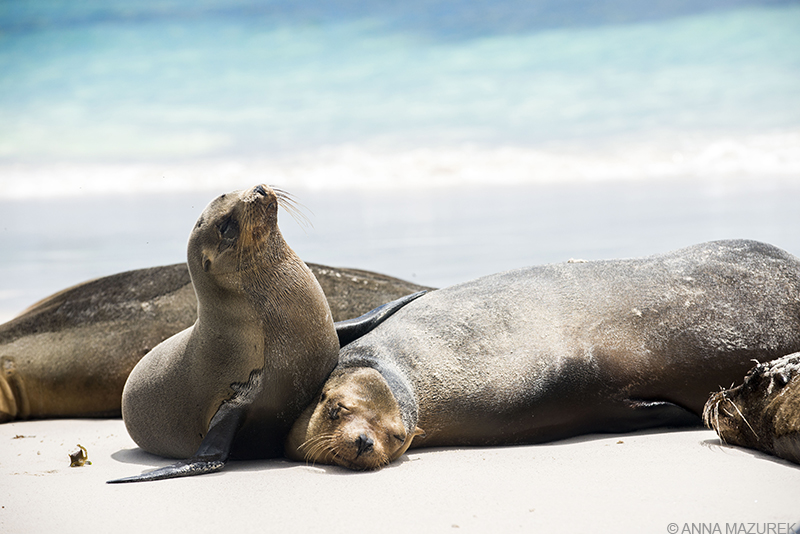Photo Guide to the Galapagos
The Galapagos was the highlight of my four-month trip to South America earlier this year was. Even though 220,000 visitor arrive each year, it’s still one of the most pristine environments in the world!
The string of 13 volcanic islands lie 1000 kilometers from mainland Ecuador. Despite being located directly on the equator, the islands aren’t tropical partially due to cold ocean currents from Antarctica. Many islands look like Mars and are void of vegetation. Despite this, they are a haven for wildlife including birds, iguanas and a rich sea life. Many of the species are endemic; they are only found in the Galapagos. The most astounding part of the Galapagos is that the animals are all environmentally naïve meaning they don’t see humans as a predator. They don’t run from you, which makes it extremely easy to get amazing photos.
Five of the islands are inhabited including the two main tourist hubs of Isla Santa Cruz and San Cristobal. Visitors are only allowed to visit official visitor sites and must be accompanied by a naturalist (a trained guide) to visit all uninhabited islands and most locations aside from the main cities. Boats are not allowed to visit the same site twice in a two-week period. Most boat trips only cover a portion of the islands due to this, which is why I only went to eight islands during my trip.
I’ve complied a detailed photo guide to my trip to the Galapagos organized by location along with helpful tips and a packing list
Day 1: San Cristobal Island
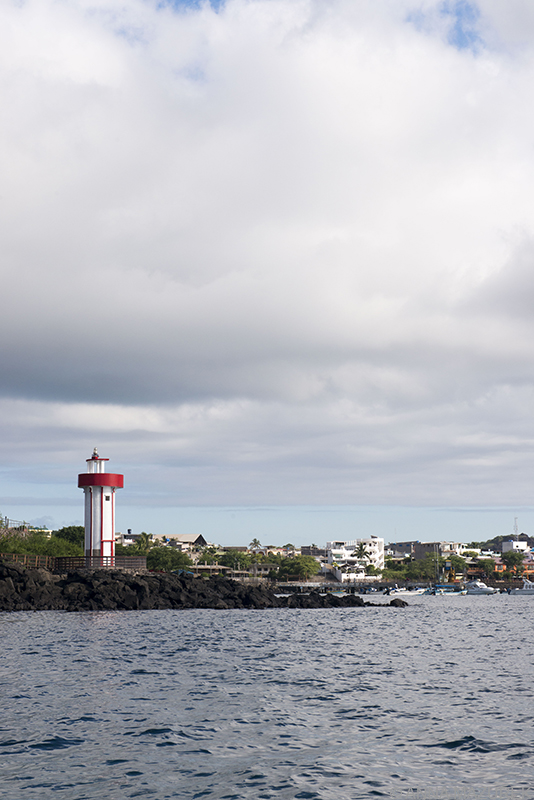
View of Puerto Baquerizo Moreno from the water. San Cristobal, Galapagos
I flew into San Cristobal, which is the only island with fresh water and an airport in town. It’s the seat of the Galapagos and has the second largest population after Santa Cruz. It’s popular day trip destination.
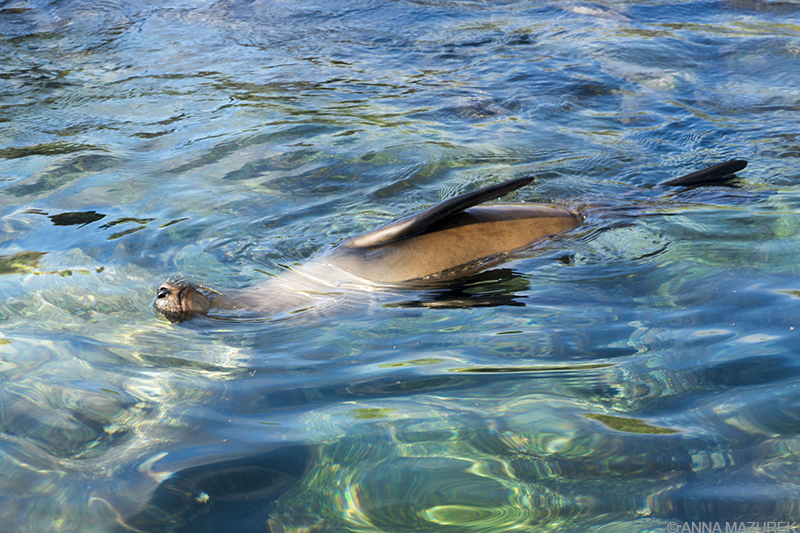
We did an afternoon boat ride through the main harbor at Puerto Baquerizo Moreno, which is a haven for sea lions. They are literally all over the harbor and even benches in the town. They’ve become a nuisance as well for boats parked in the harbor. The island has two nice white sand beaches and a freshwater lake at 700 meters above sea level.
Day 2: Espanola
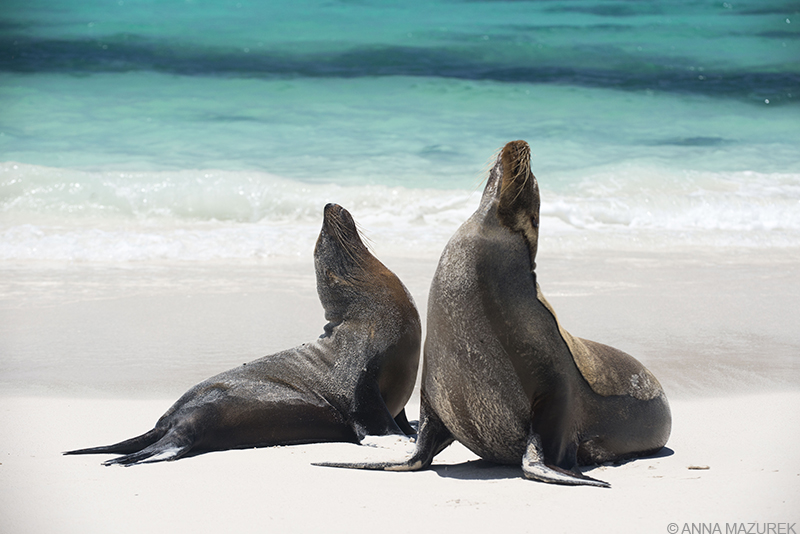
Espanola is one of my favorite islands. If you love birds or sea lions, then this is your island. Gardner Bay is one of the most stunning beaches in the Galapagos. The long white sandy beach is literally covered with sleeping sea lions. There’s also a good population of marine iguanas.
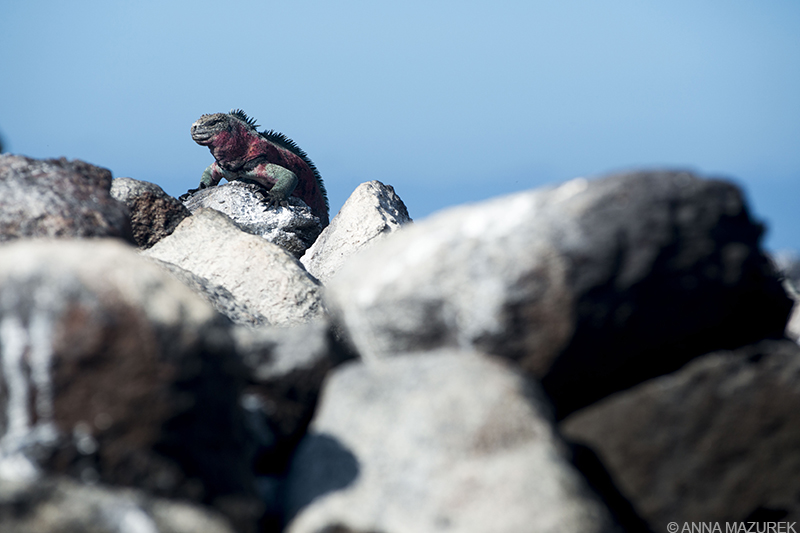
The marine iguanas on Espanola are the most colorful in the Galapagos and are often referred to as “Christmas Iguanas.”
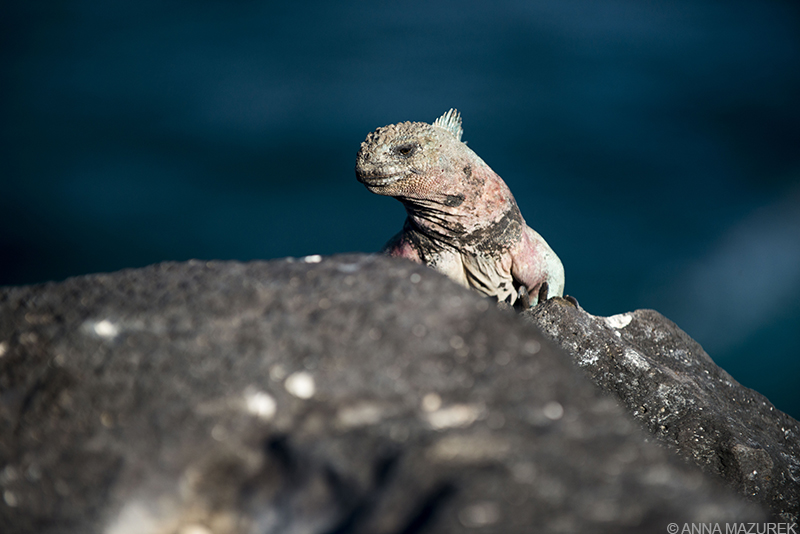
Marine iguanas are thought to have reached the Galapagos on rafts of vegetation from continental South America.
There’s a two-kilometer long trail starting at Punta Suàrez that weaves through colonies of Nazca and blue-footed boobies. There’s a blow-hole along the path as well. The waved albatross is one of the unique and main features of the island. These large, monogamous birds have a long, curved beak and mate on the island usually between December and March. This year the rains came late this year so they had not started mating yet when we arrived in early April. We saw many of them flying but none on the ground so I only have photos of an albatross flying.
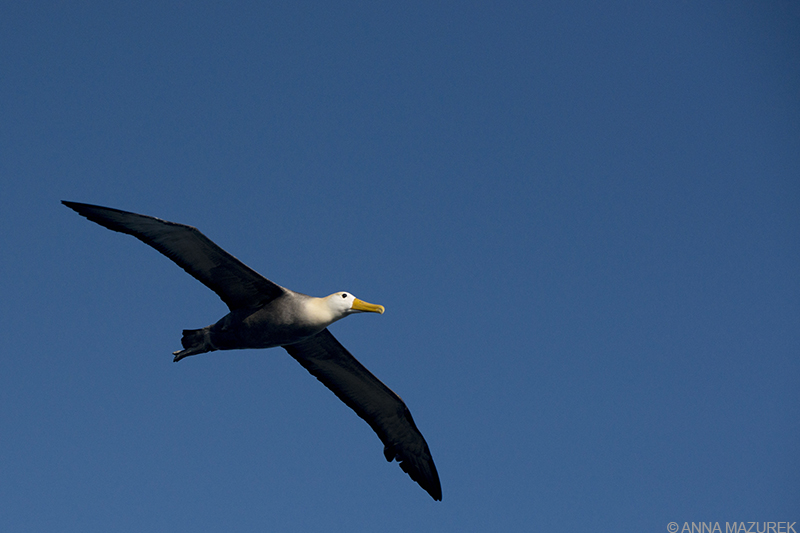
The waved albatross, also known as the Galapagos albatross, has the longest wing span of any bird in the Galapagos.
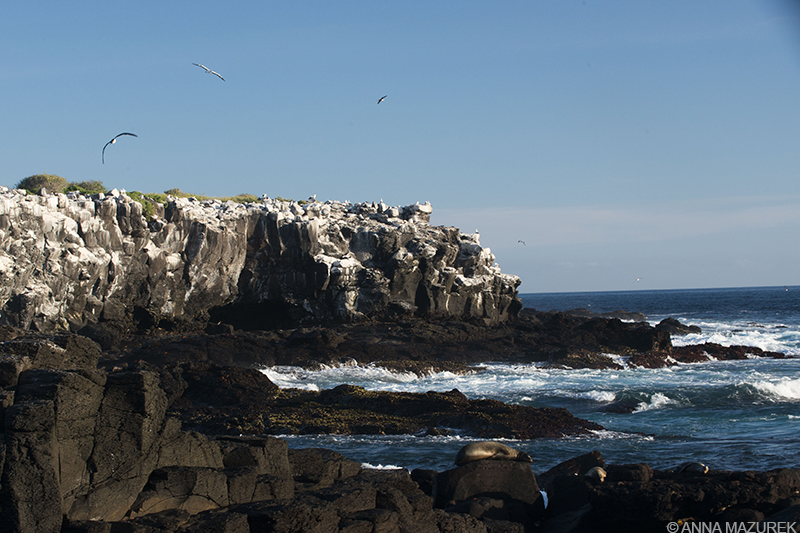
The waved albatross and Nazca boobies soar above the cliffs of Espanola island near the saltwater blowhole.
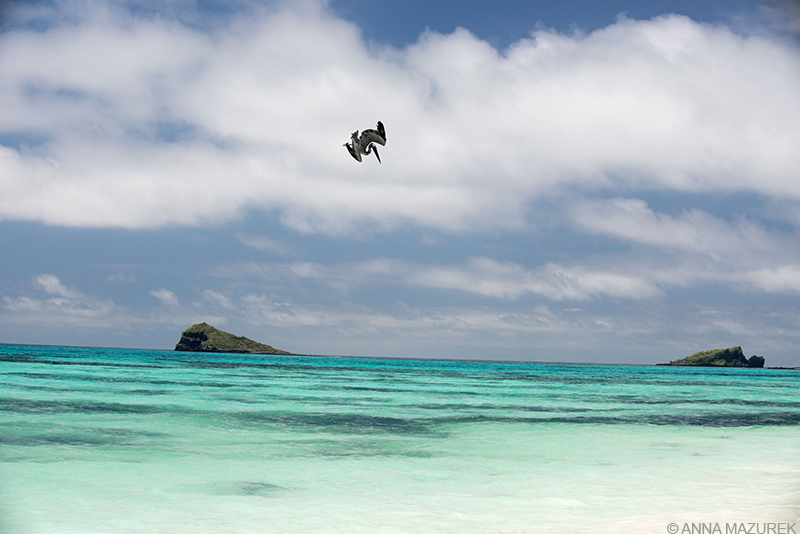
A brown pelican hunts for fish off of Gardner Bay on Espanola Island.
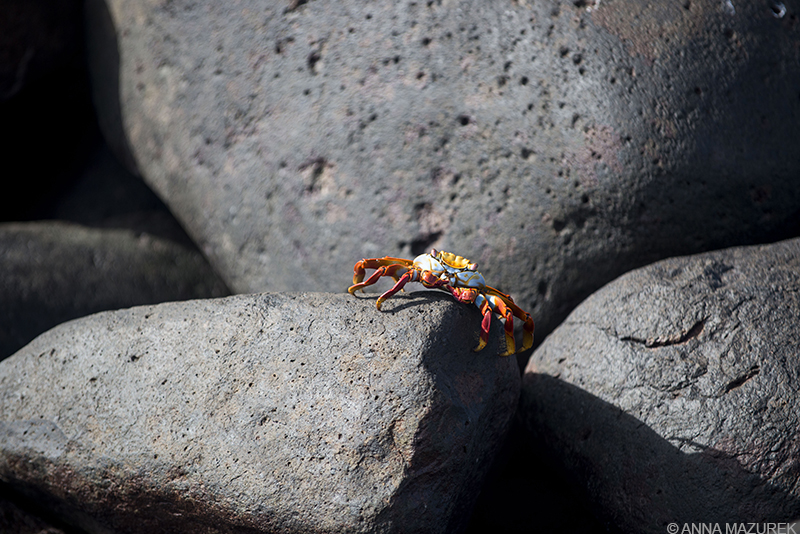
The colorful Sally Lightfoot Crabs were on every island we visited in the Galapagos.
Day 3: Floreana & Post Office Bay
We saw a lot of blue footed boobies nesting and mating just by the boat landing spot on Floreana. The males were doing the mating dance and bringing sticks for the nest. There is a lagoon here with a chance of seeing flamingos, but there aren’t many flamingos. Sadly, they were too far away for photos.
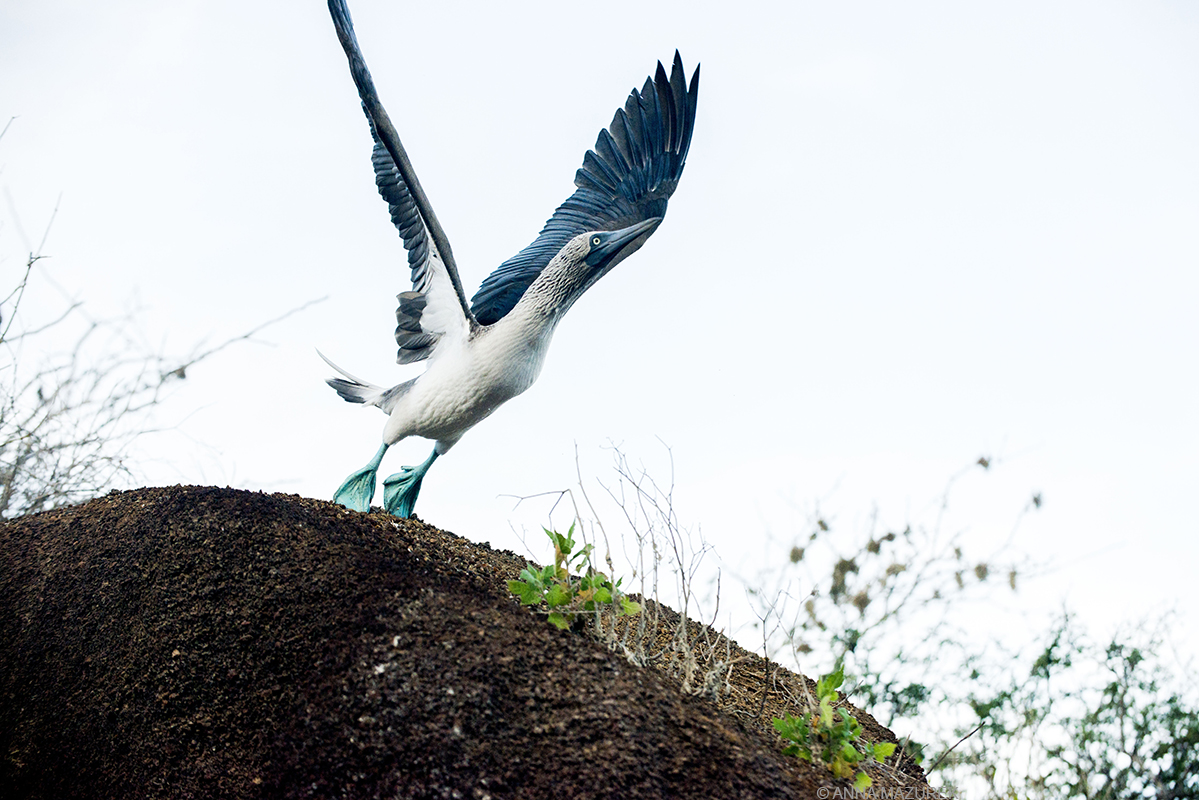
Blue-footed boobies show off their feet to impress their mates. The bluer their feet, the more attractive they are to females.
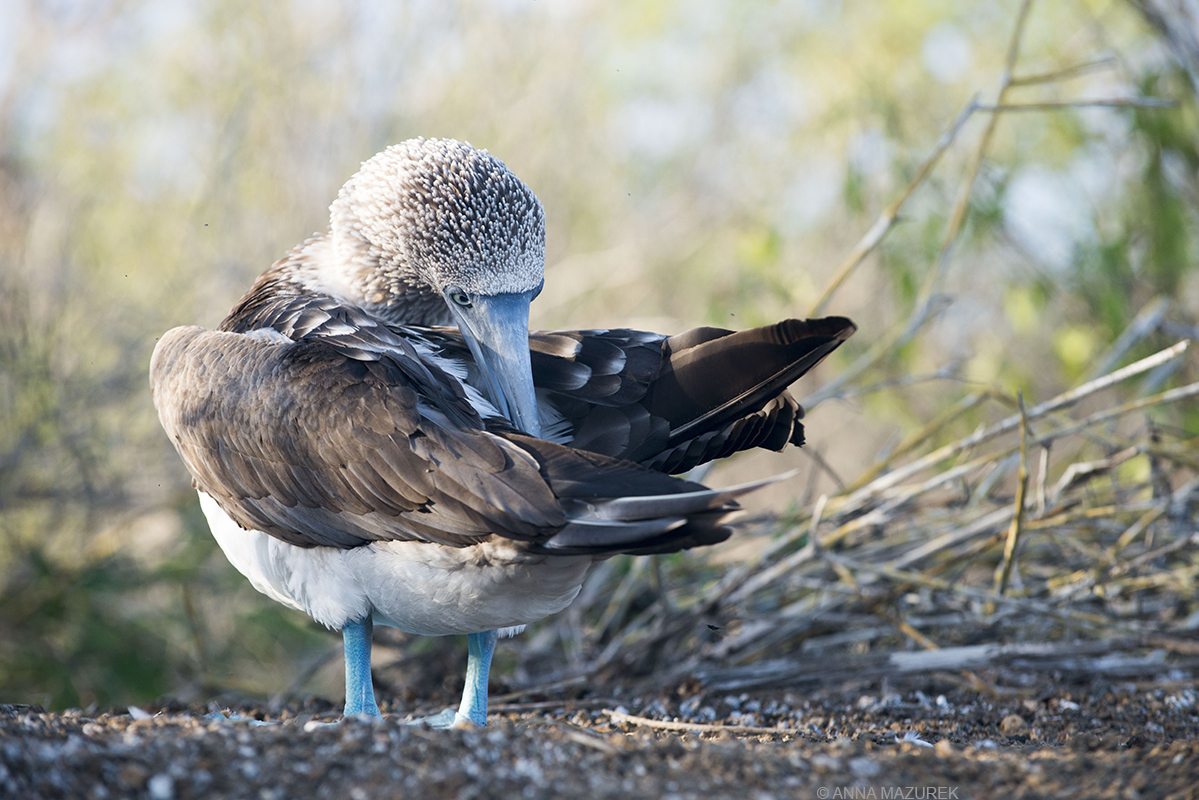
The blue-footed boobies have an oil gland in the back of their body. They use their beaks to spread the oil to waterproof their feathers.
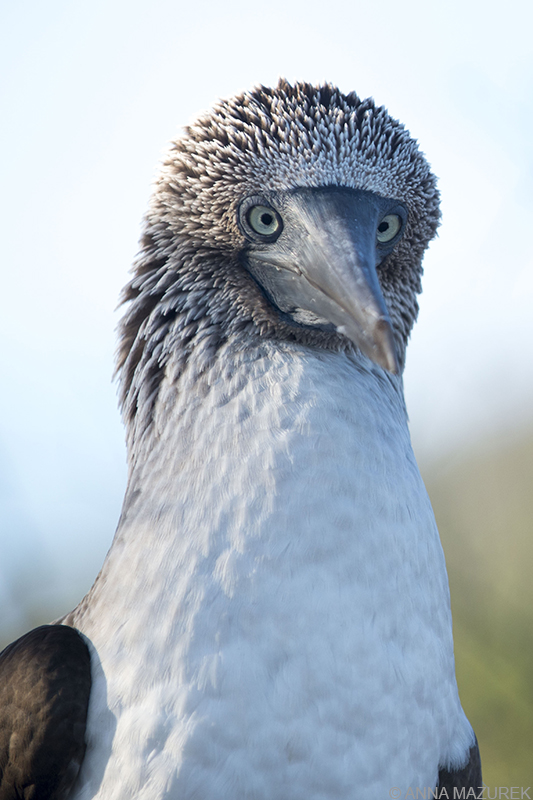
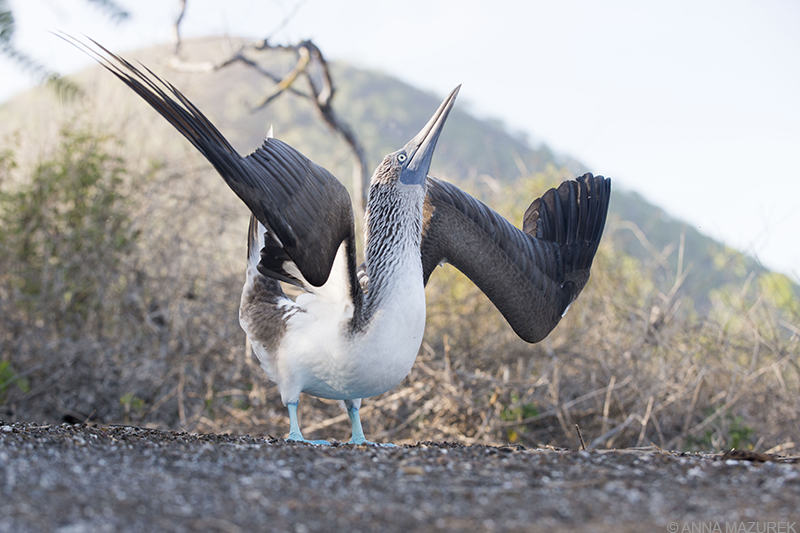
The male blue-footed booby performs a mating dance for the female. The Galapagos account for half of all breeding grounds for the birds.
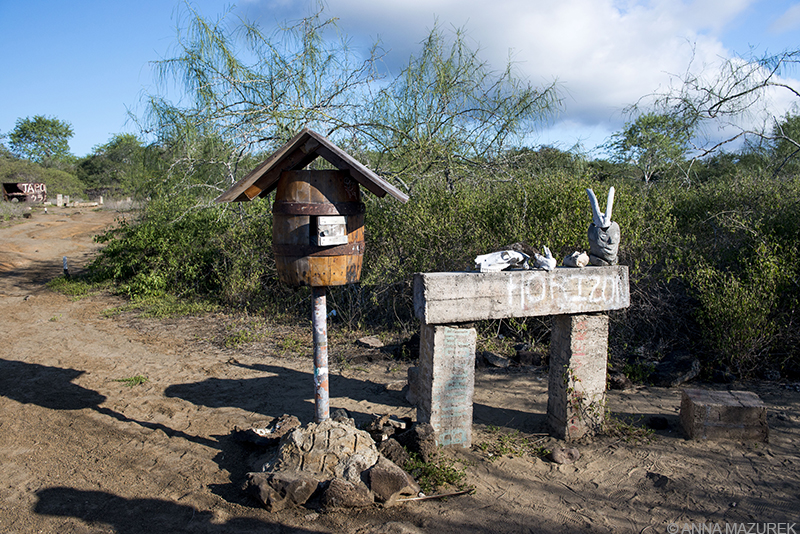
Post Office Bay is an old mailing stop for whalers in the 18th century.
Post Office Bay was once a functioning mail stop for American and British whalers in the 18th century. Now, it’s a spot for tourists to leave postcards in a barrel in hopes that another traveler will pick them up and hand deliver them to the address. I picked up two. One is in Texas that I hand delivered and slid into the gate of a fancy house. The other is near my hometown, but it’s farther than I thought so I’ll probably cheat and mail it. One of the two postcards I left was mailed. The other has yet to arrive!
The bay is an excellent spot to paddleboard and kayak. I did both and LOVED it. There were tons of sea turtles and great sea life. Paddle boarding is really easy at every single spot in the Galapagos.
Day 4: Santa Cruz
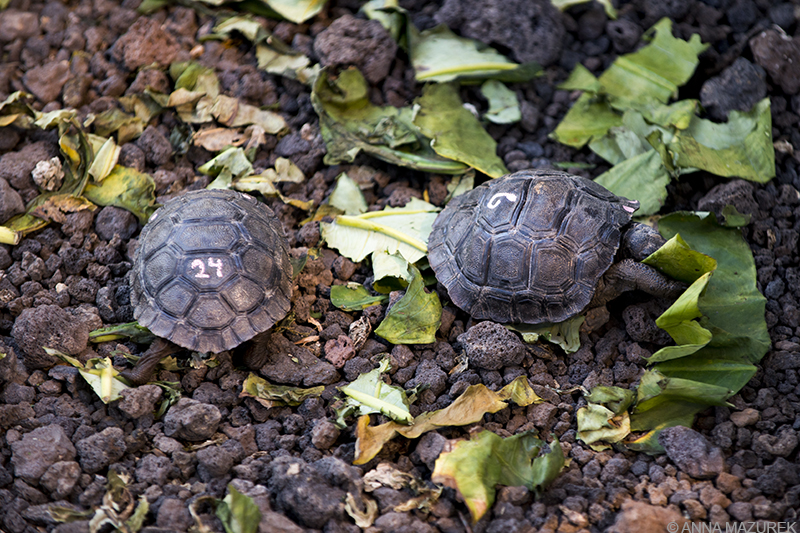
These baby tortoises are part of the breeding program at the Darwin Center on Santa Cruz island in the Galapagos. They are labeled by number and released in the wild once they reach a certain age.
Puerto Ayora is the main hub on Santa Cruz island and home to a population of 18,000 making it the largest town in the Galapagos. It’s home to the Charles Darwin Research Center, which is famous for its giant tortoise breeding program. There’s a plethora of outdoor pins with various ages of tortoises and an air-conditioned facility where you can view the preserved body of Lonesome George, the last member of the Isla Pinta subspecies. I didn’t find the center to be very photogenic or interesting from a photography standpoint.
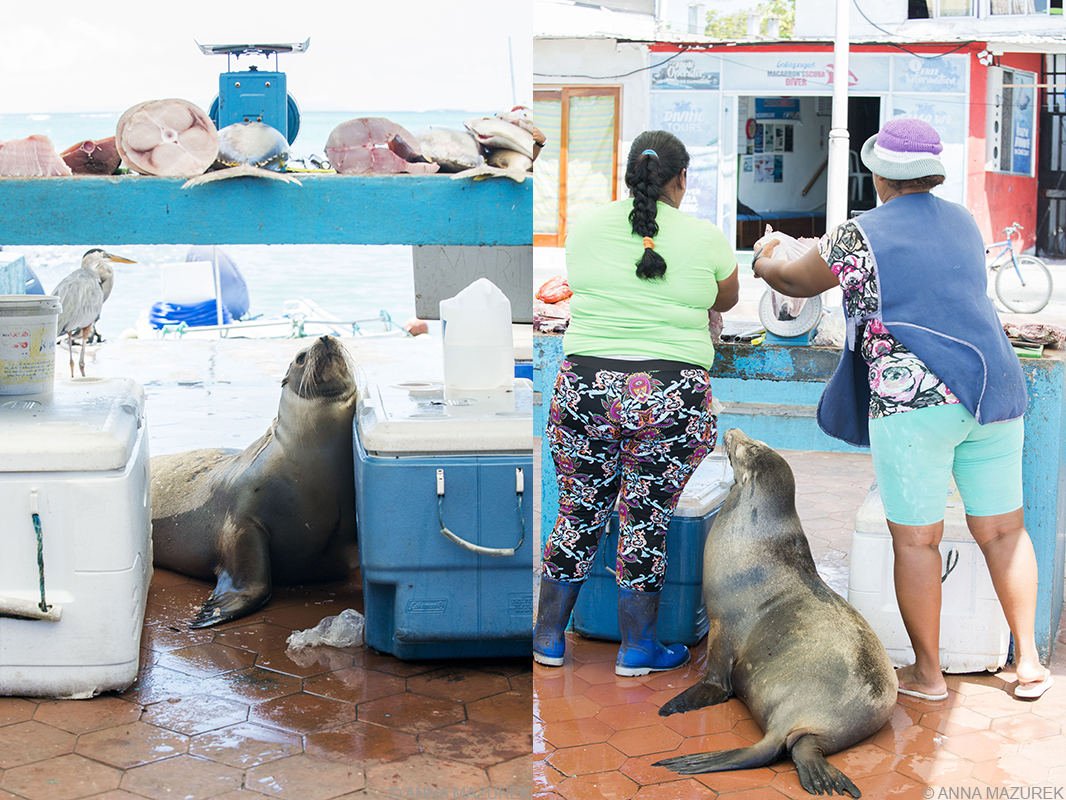
The resident sea lion at the fish market was one of my favorite parts of Santa Cruz.
My favorite part of the island was the tiny fish market. There’s a resident sea lion that hangs out next to the women gutting the fish along with a few pelicans. Apparently, the sea lion was abandoned and raised by the people at the fish market. It’s a great thing to photograph. Santa Cruz is also the best place to do your souvenir shopping.
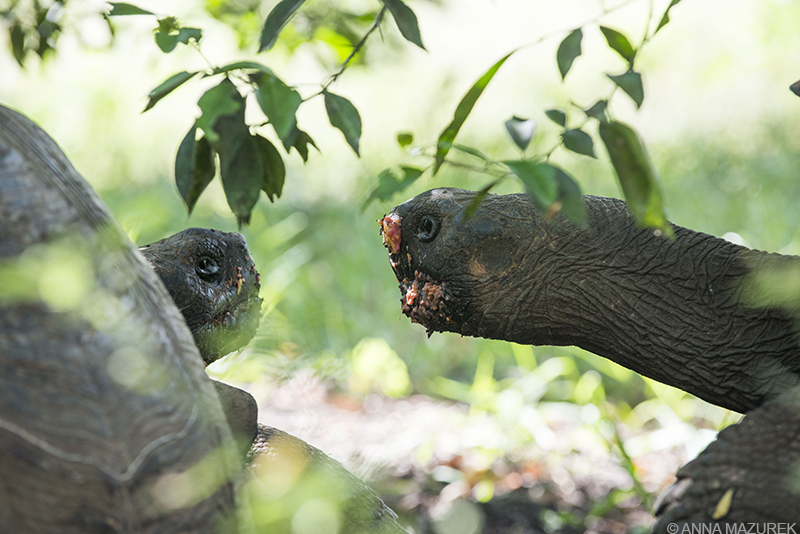
Two giant tortoises with guava fruit on their faces stare each other down after a fight.
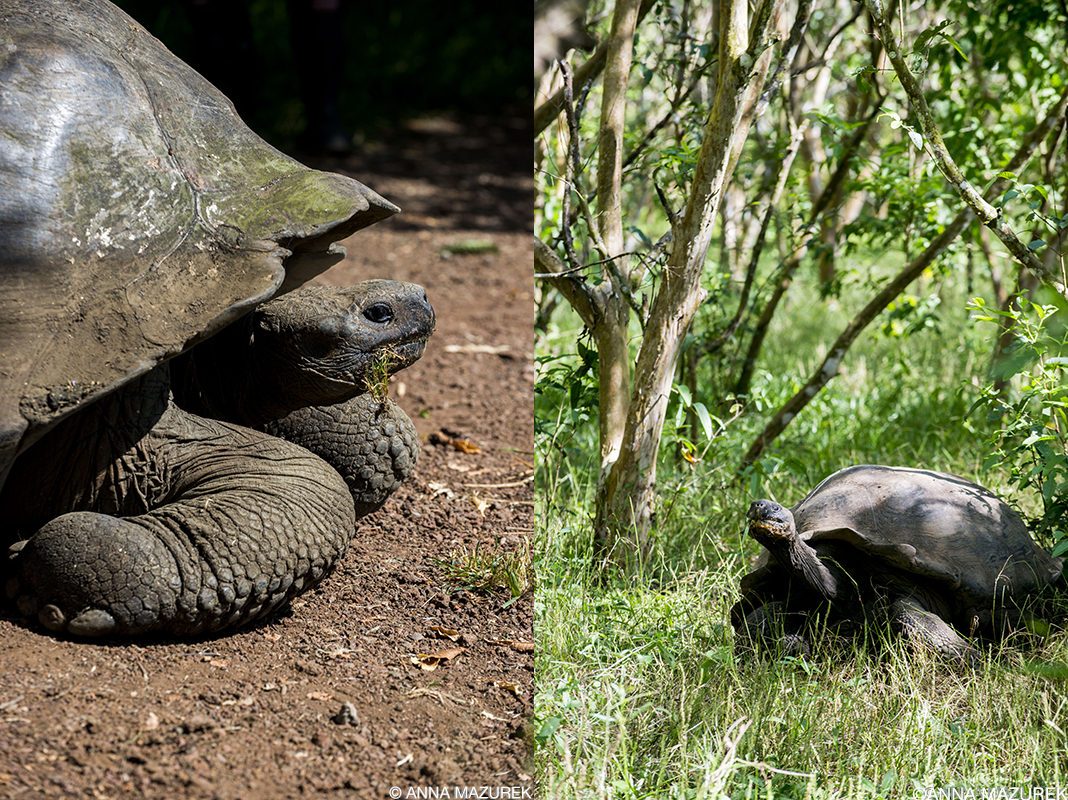
Giant tortoises can be observed in the wild at El Chato Tortoise Reserve on Santa Cruz.
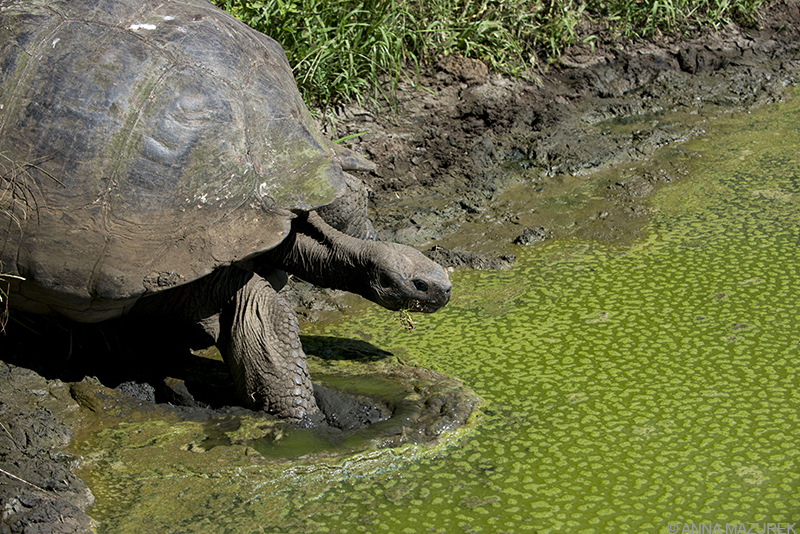
Be sure to wear long pants and rubber boots when wandering through the wildlife preserve to photograph the giant tortoises.
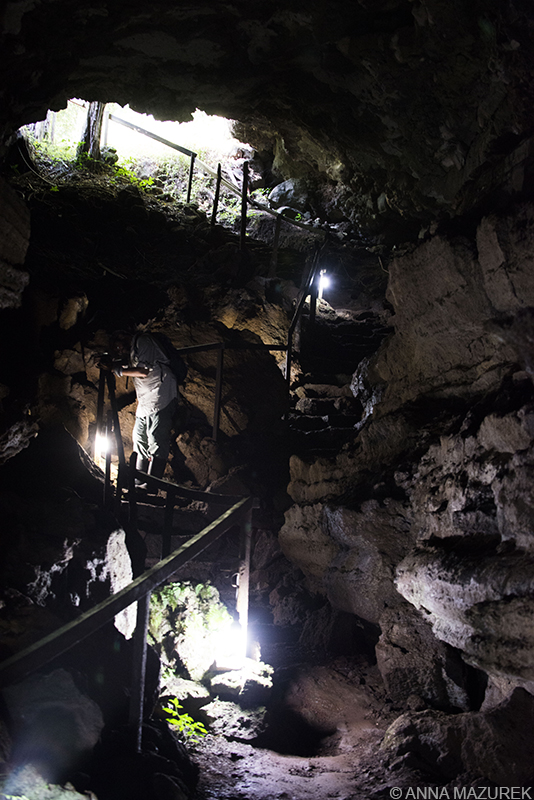
A lava tube cave near El Chato Tortoise Reserve
Day 5: Santa Cruz & Daphne
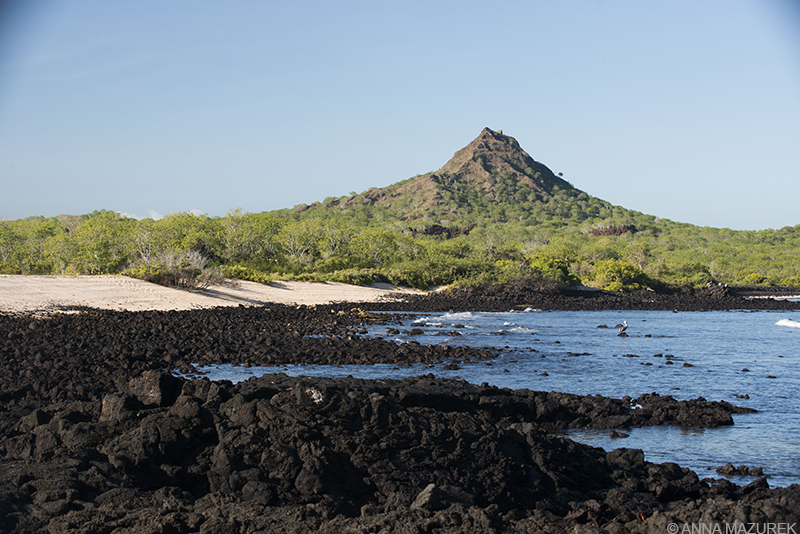
Cerro Dragon on Santa Cruz island
On the northwestern corner of Santa Cruz island is Cerro Dragon, which has a 1.75 km trail that offers a great chance to see colorful land iguanas en route to a small hill with nice views.
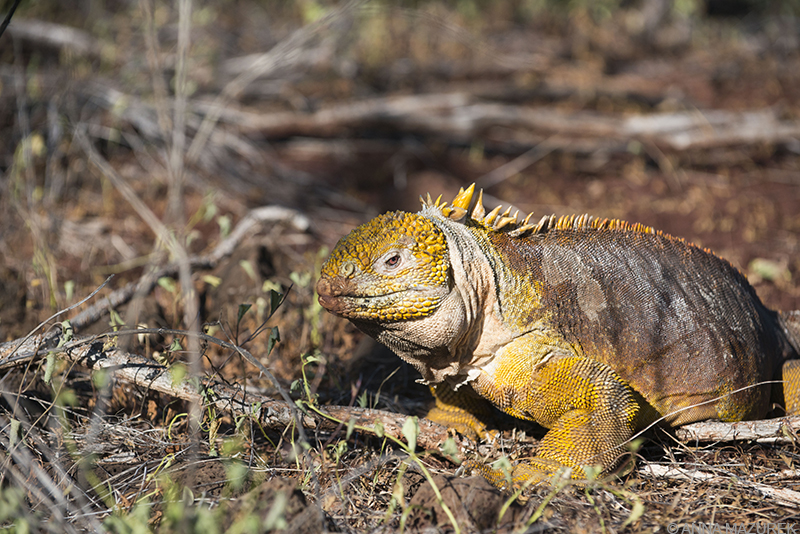
The land iguanas were much larger than the marine iguanas. We saw a handful on our hike.
I visited Islas Daphne, which consist of two islands – Daphne Major and Daphne Minor. The island is home to both blue-footed boobies and Nazca boobies. The island is tricky to visit due to the landing. You have to disembark the boat onto rocks then climb steep stairs. I found this really easy since my boat tour had staff to assist with the landing. Another highlight of this island was the school of baby black tip sharks and rays swimming near the beach!
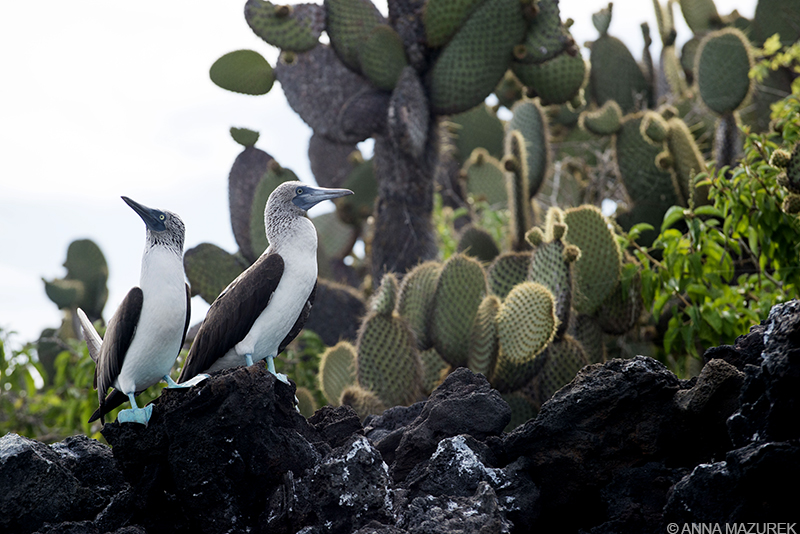
A pair of blue-footed boobies
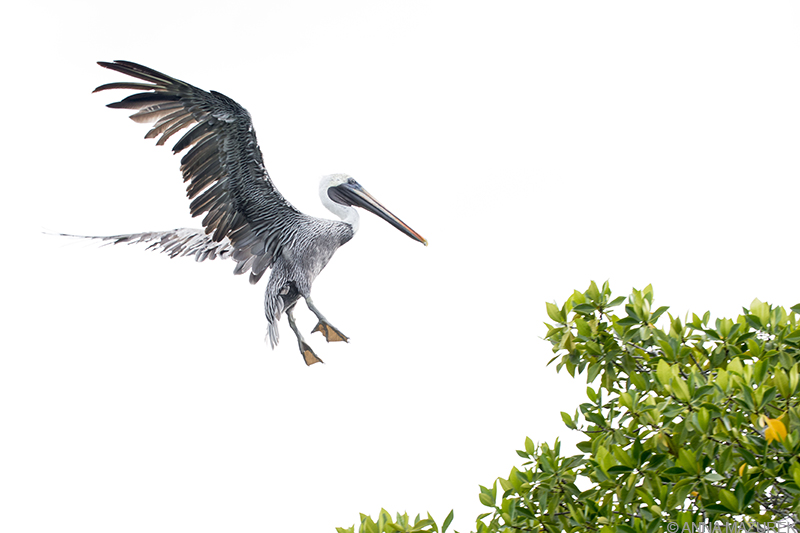
Brown Galapagos Pelican
Day 6: Bartoleme & Sombero Chino
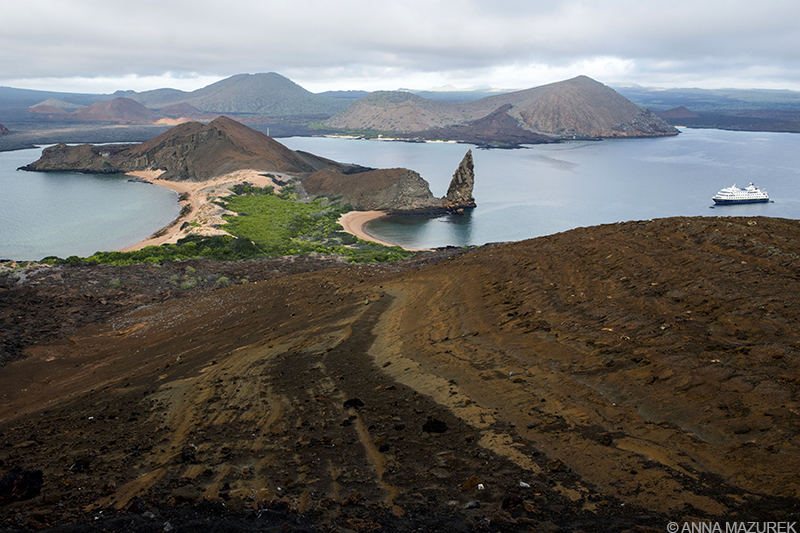
The famous view from Isla Bartolemé
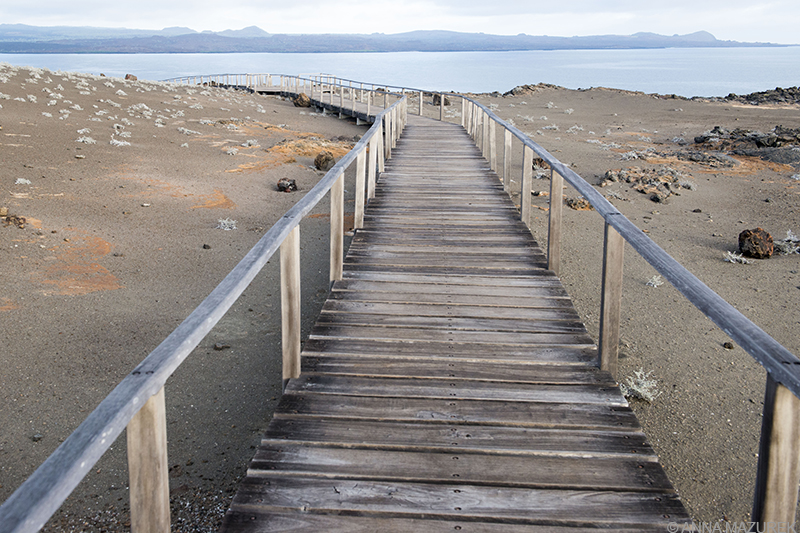
Chances are you’ve seen the iconic panoramic view from Isla Bartolemé. A wooden boardwalk weaves through a volcanic landscape toward a 375-foot summit that offers a sweeping peak of the white sand cover below. The coolest part of the island was snorkeling in the area. One of the penguins jumped into the water like a torpedo! There were a few other sets of penguins along the coast that we were able to photography from our boats. It was one of the coolest snorkeling days on the trip! (I don’t have any type of underwater camera so I have no photos from snorkeling.)
Here are some of my favorite Galapagos penguin images:
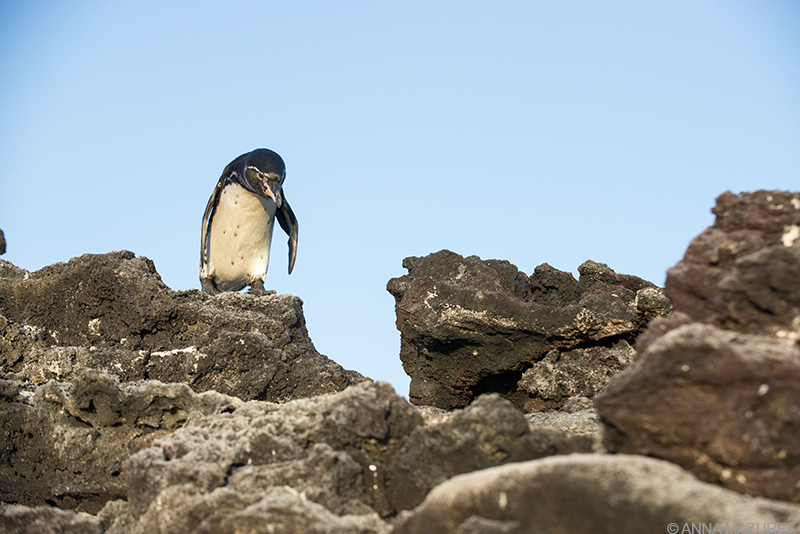
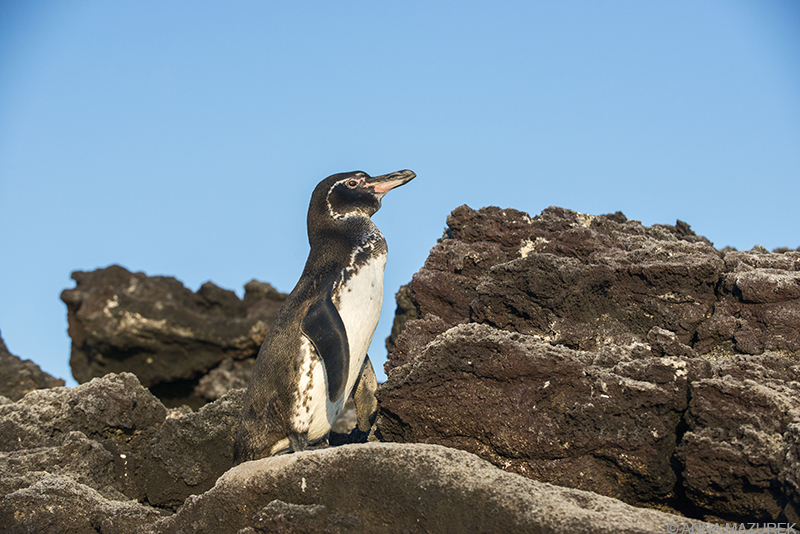
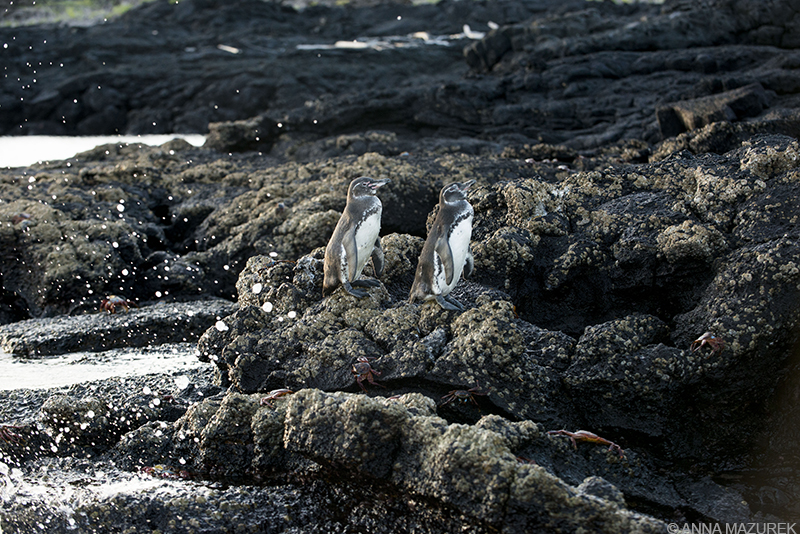
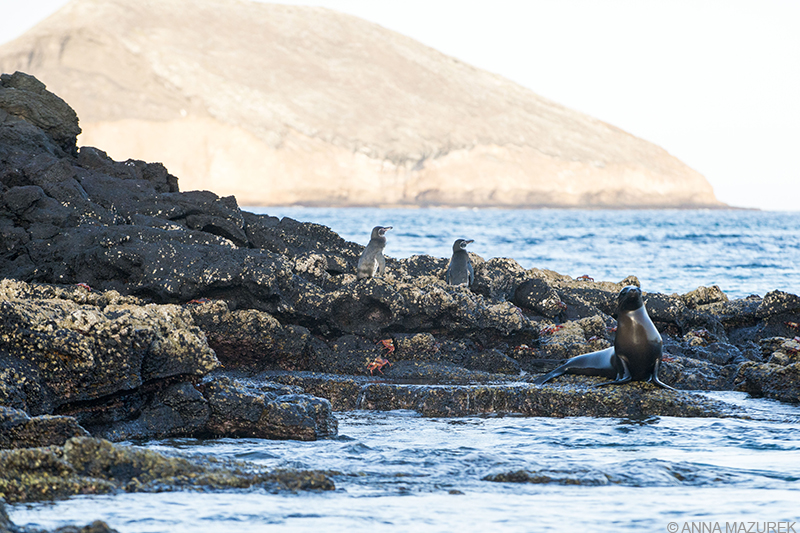
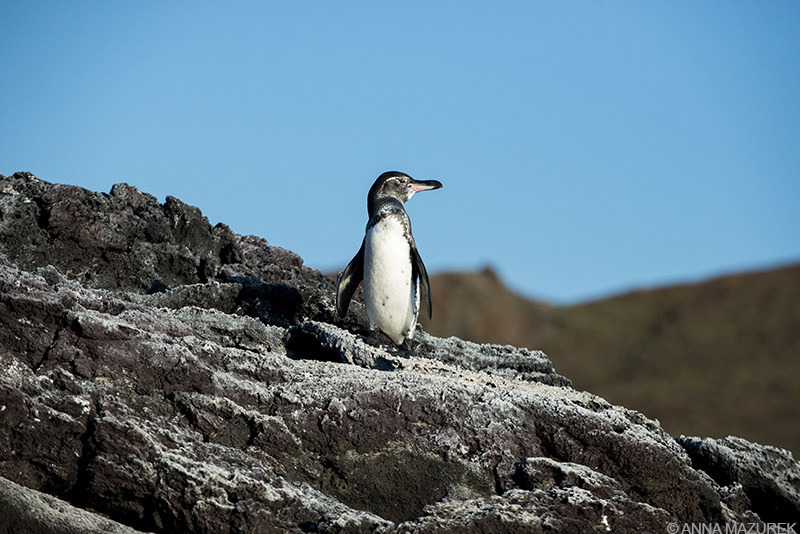
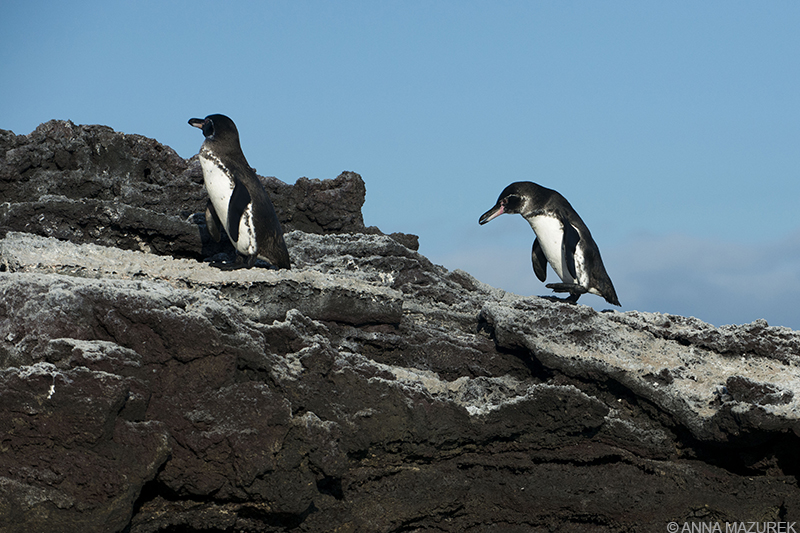
Sombero Chino is a conical shaped island that looks like the “Chinese hat” the island is named after. The island is tiny but offers a short trail offers access to snorkeling/swimming options. Animal life includes sea lions and a marine iguana colony.
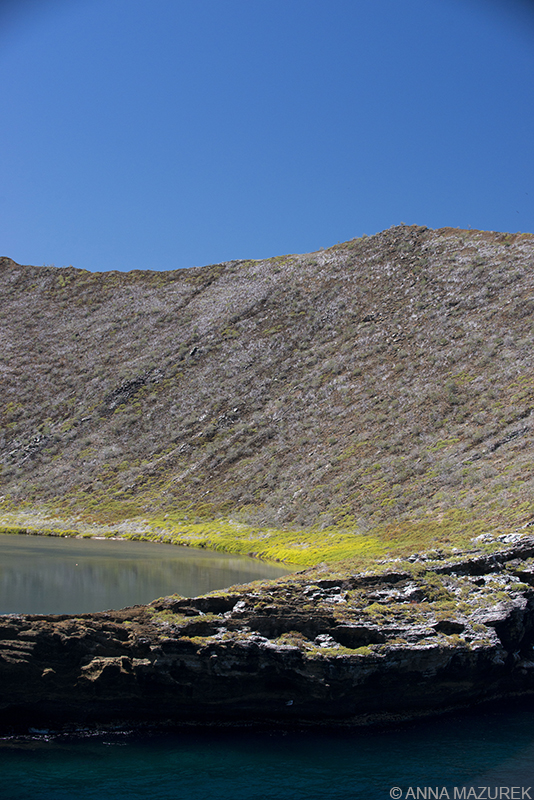
Sombero Chino shot from our boat.
Day 7: Genovesa
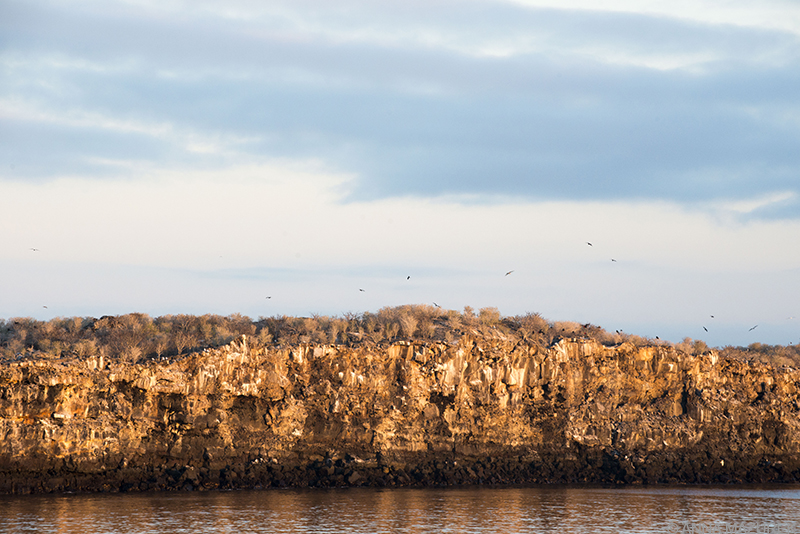
Genovea is a bird-lovers dream. It’s the best spot to view red-footed boobies and the equally photogenic frigatebirds—the males are known for their bright red featherless throats that they inflate during mating season to attract females. It’s one of my favorite islands next to Espanola. An added perk is that you cross the equator to reach the island!
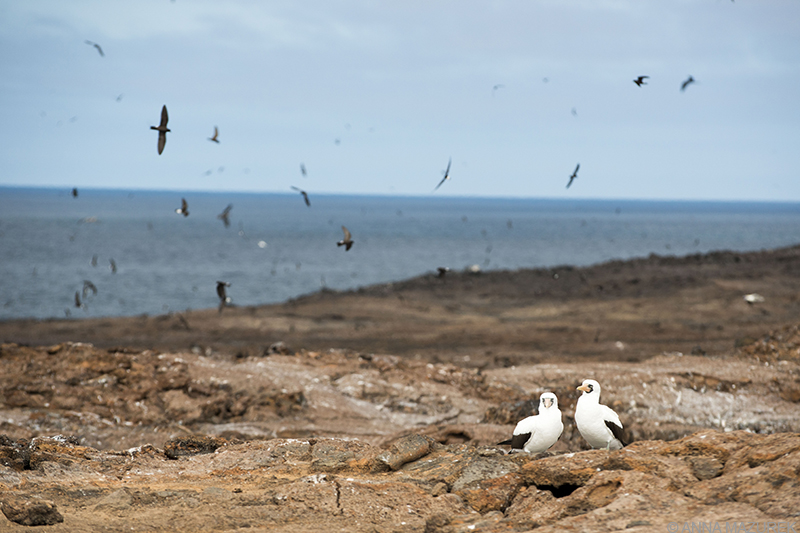
Nazca boobies, Genovesa island
There’s two main sites to visit on the island—Darwin Bay Beach, a coral beach with a 750 meter trail that winds through a hot spot of bird breeding grounds. The Prince Phillip steps are the other site. This is a dry landing that starts with a few steep steps and a one kilometer trail that leads inland. It’s a great spot to see short-eared owls, which we were lucky of enough to see. It was too far away for a decent photo though!
These are a few of my favorite frigatebird photos below:
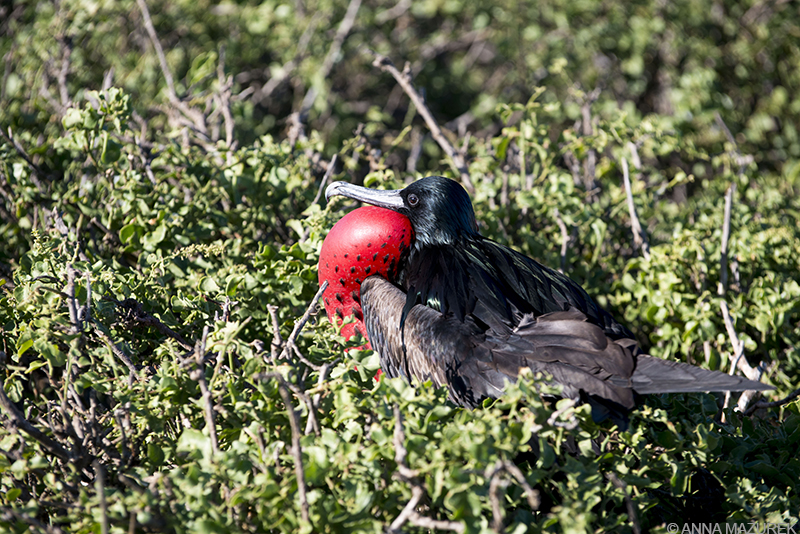
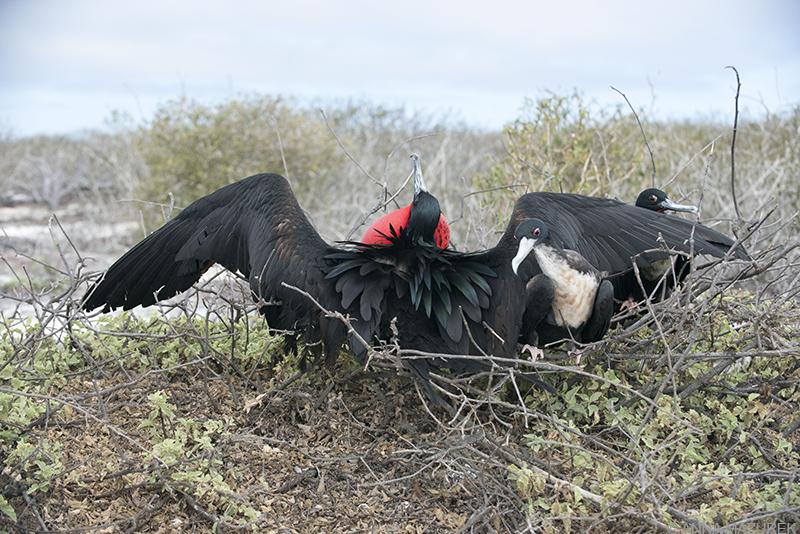
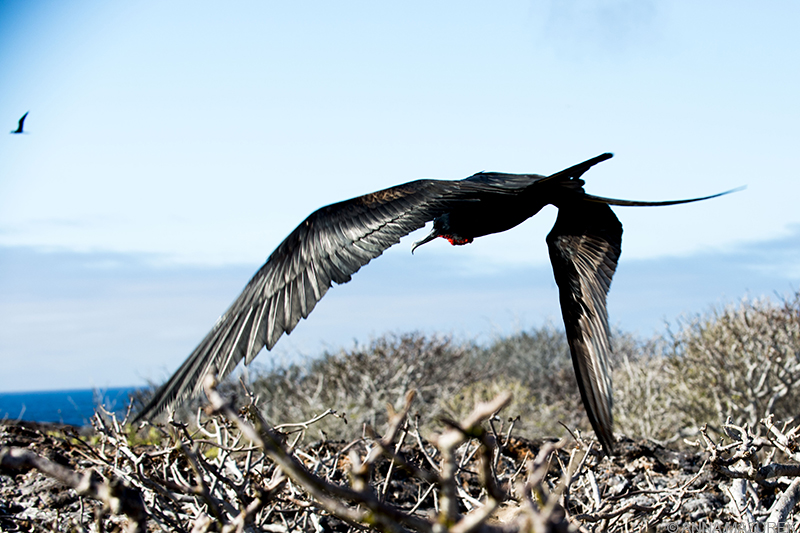

Red-footed bobbies (left) and Nazca boobies (right) both use Genovesa island for mating.
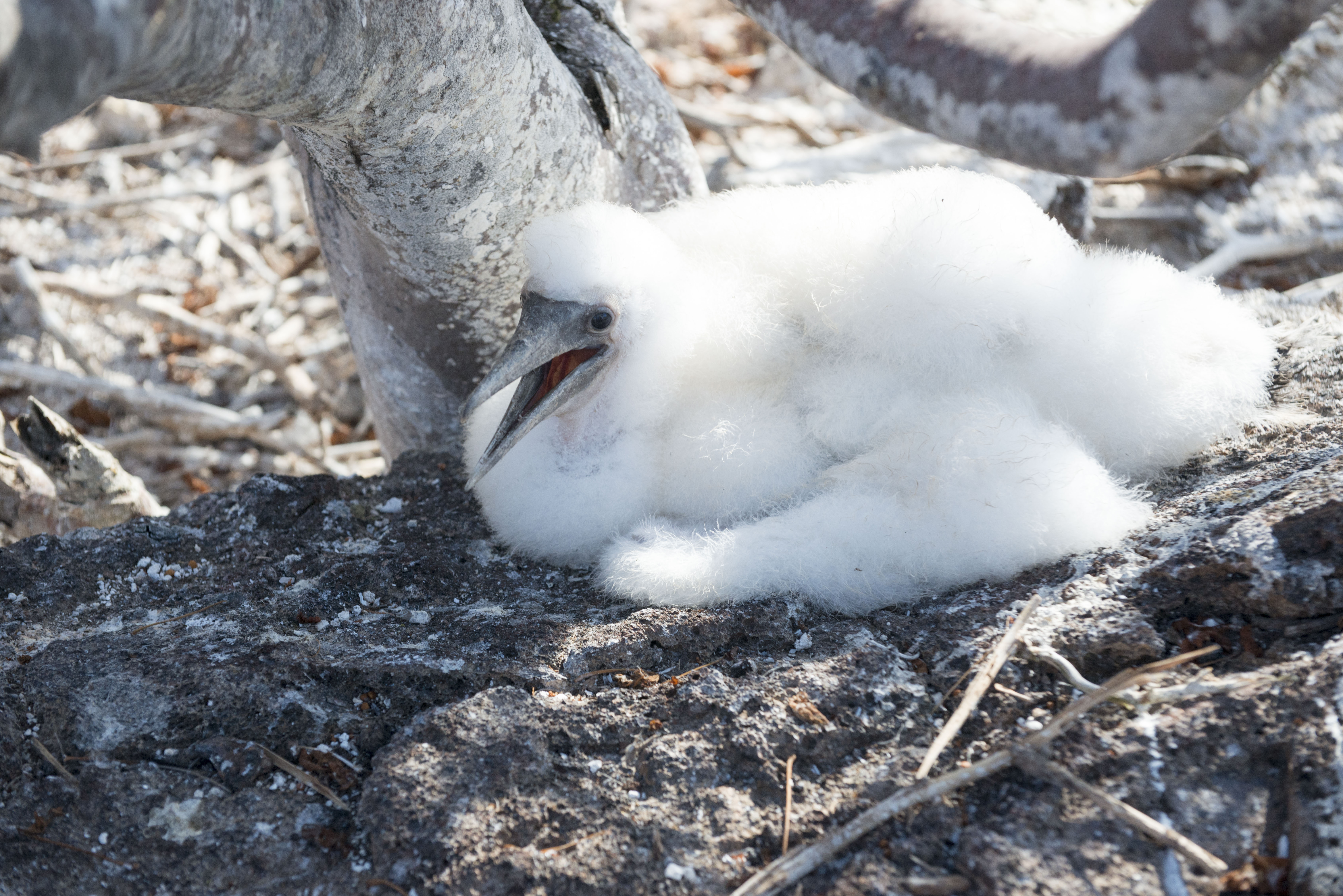
A baby Nazca booby
When to Go to the Galapagos
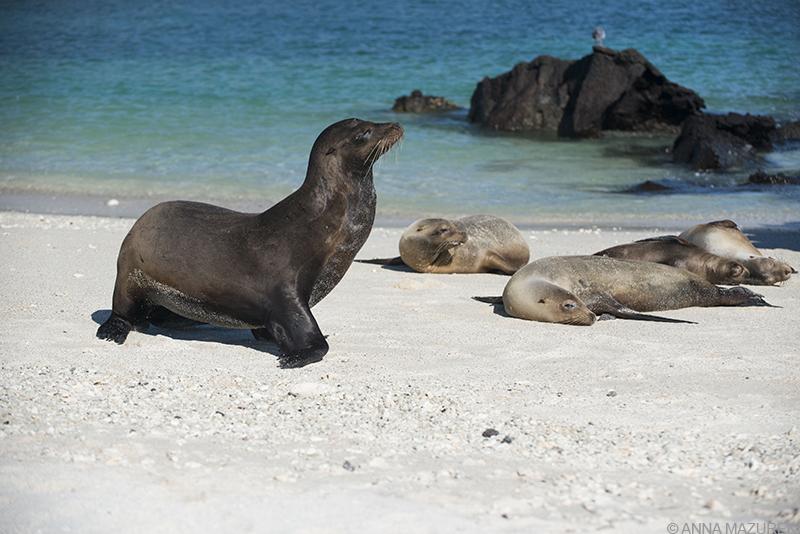
December through May is the warmest time of the year and the rainy season. Expect a daily drizzle or two. There is less fish this time of year, but it’s the best time to see turtles nesting on beaches. It’s also mating season for sea lions, birds and land tortoises so they will be very active.
The weather is sunny (averaging 85 F) with occasional showers. Seas and winds are calm.
As the weather cools, the water gets choppier from Humboldt current that comes from Antarctica from June to December. Birds and sea mammals are the most active in the dry season. It’s best for marine life if you dare to plunge into the cold water. The plus side is that the cold water brings a higher chance of penguins sighting.
Seas are rough from July to October. During the dry season (June-December), the weather is cool and misty. Peak seasons coordinate with school vacations – mid-June to early September and mid-December to mid-January. Those prone to seasickness should visit when the water is calmer from February through April.
Snorkeling
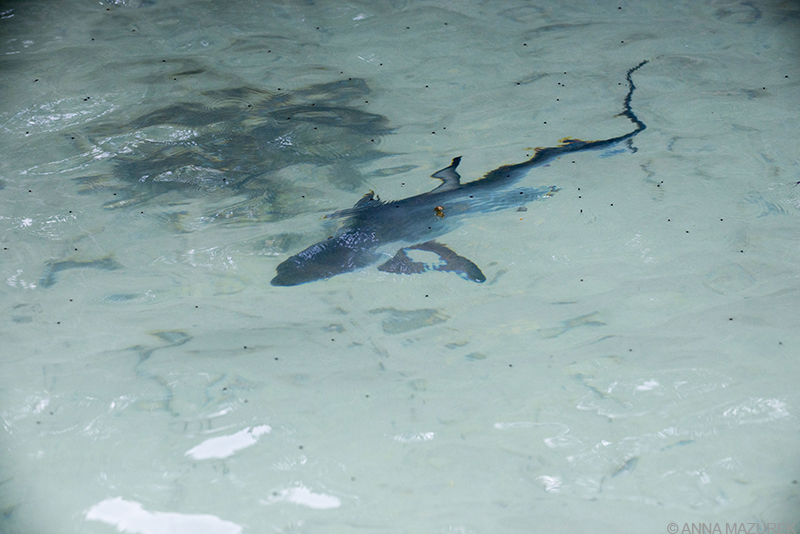
I photographed a school of black tip sharks from our boat while we were heading to shore one day.
The water was in the low 70s F while I was there, which is the warmest of the year. I still needed a wet suit and after about 45 minutes, I had to get out of the water because I’m super cold natured. We saw a lot of white tip sharks during our daily snorkeling trips. Some were of a substantial size, which freaked me out but the naturalists weren’t concerned. Other snorkeling highlights included sea lions, sea turtles, rays and every type of fish you can imagine.
Galapagos Packing List*
Camera Gear
This is a list of the gear I took with me to the Galapagos along with a few suggested items.
- Nikon D800 Body (The D810 is the most current version of my camera)
- 24-70 mm f/2.8 lens: This was great for wide angle shots.
- 70-200 mm f/2.8 VR lens (This was the lens I used the most to get close to the animals. The only exception was for wide angled shots like the scenic view from Isla Bartolemé.)
- Circular Polarizer Filter: This is essentially to cut the glare from the sun on the water and the sky. At a 90-degree angle from the sun, this filter makes the sky appear bluer by bending the light. You’ll need a different one for each size lens or a step ring to use the same filter on another lens.
- Lens cloth: Your lens will fog when you step out of the air conditioning to the humidity. I advise going outside 15 minutes before you are supposed to depart for an island to let your lens can de-fog so you won’t miss any photos!
Packing Essentials:
- Eco-Friendly Toiletries & Sunscreen: Most ships will give you biodegradable toiletries. Be sure to only use natural sunscreen that’s free of Oxybenzone, a chemical that damages coral. Check out my post about 14 Easy Ways to be an Eco-friendly Traveler for more ideas!
- SPF Clothing: I packed my trusty Columbia button-down wicking/SPF hiking shirt that I bought for Kilimanjaro. It was a lifesaver!
- Hiking pants: Consider packing hiking pants that either zip into shorts or roll up into capris. I love the prAna halle style hiking pants.
- Quick-dry shorts: I LOVE these Patagonia shorts I bought last year. They dry super fast and are perfect for hikes!
- Wide-brimmed Hat: Every single staff member on the ships is covered from head to toe from the sun. You should do the same. Again, I packed my silly but amazing wide-brimmed REI hat. This was yet another purchase from my Kilimanjaro trek that’s still useful!
- Dry Sacks: Since we traveled by boat everywhere, I had a dry sack handy for my camera on the boat trips just in case.
Things I didn’t pack but wish I had:
- Longer zoom lens: A 70-400 mm would have really helped with the animals. Even a much cheaper 300 mm lens would have helped!
- GoPro or underwater camera: I missed out on underwater photos but I just can’t justify dropping $300 + on a GoPro just for a 10-day trip. I booked last minute so I didn’t have time to borrow a friend’s, which is what I normally would have done. My friend’s GoPro Hero 5 was great on our Havasu Falls trip. I wish I’d had it for the Galapagos!
- Long-sleeve rash guard with UV protection: I was jealous of every person who had one especially when we were snorkeling!
- Water shoes: I managed with flip-flops and hiking boots. I did envy all the people in basic cheap Crocs, Chacos and Keen sandals who didn’t have to sit on the beach and dry their feet off before changing shoes.
*Please note some Amazon and REI affiliate links are included above. If you click on the link and make any type of Amazon/REI purchase, I earn a small commission with no additional cost to you. I hope you found this post helpful and appreciate your support of the blog. Please email me if you have questions.
____________________________________________________
COMING UP NEXT
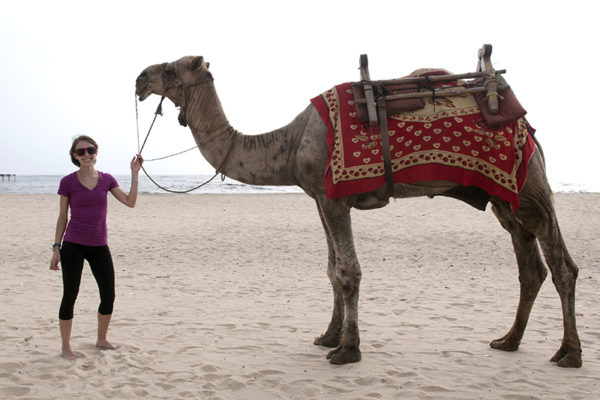
I head to Mongolia next week, which means more CAMEL photos! Follow along with my adventure on Instagram at @AnnaMazurekPhoto. I won’t be posting again until the end of August or early September. I’ve got a lot of posts I’m working on including Havasu Falls, Cuidad Perdida, my favorite London neighborhoods & Prague!

